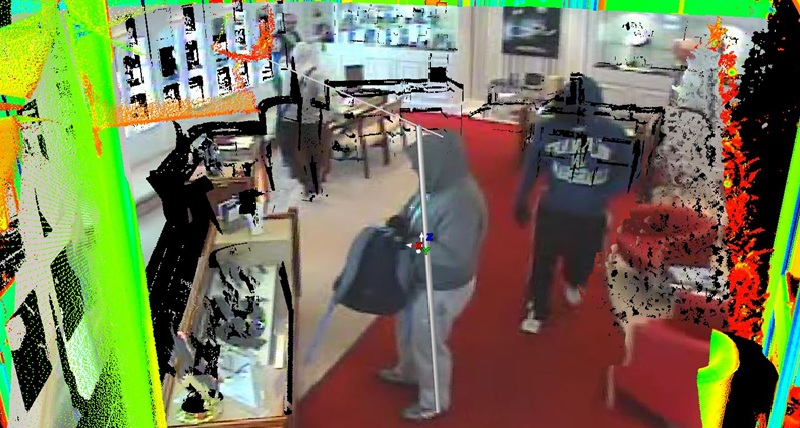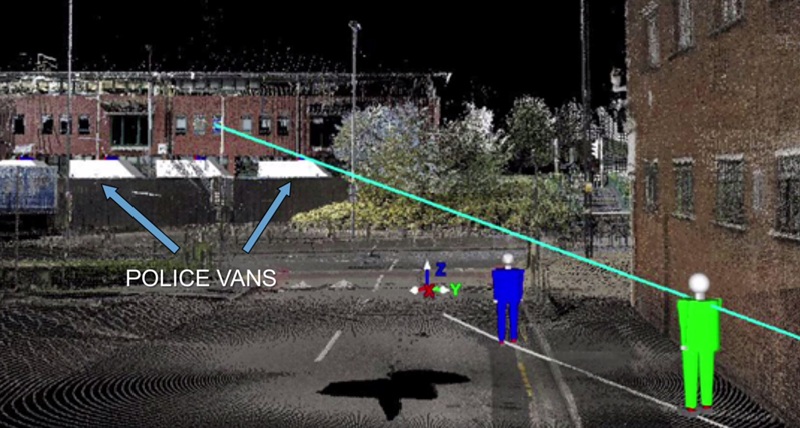Criminal convictions in West Yorkshire aided by Leica's 3D technology
West Yorkshire Police has achieved a string of criminal convictions thanks to their innovative blending of 3D laser scanning and CCTV technologies.

Dan Sharp was working as an electrical surveyor when he saw that West Yorkshire Police were advertising for a crime scene surveyor, and his interest was piqued. He applied, got the job, and has never looked back. Today he’s senior imaging officer in Wakefield, managing a civilian team which provides forensic imaging services for the four regional Yorkshire forces and, on request, other forces around the country. They work with a range of media including video, photography, CCTV and 2D/3D modelling.
Despite his modest demeanour, Dan has developed some revolutionary forensic technology applications using CCTV in combination with 3D laser scanning technology. 3D laser scanning is also sometimes known as LiDAR and is used to produce highly accurate 3D ‘point clouds’ (scans) for 3D digital modelling.
Figuring out how to solve complex evidentiary challenges in this way has won Dan a national innovation award from Leica Geosystems, a leading provider of 3D laser scanning equipment to UK police forces. It has also taken him to a conference in Las Vegas, where he presented his techniques to police officers from across the USA, who said they had “never seen anything like it”.
Laser scanning and ‘image stitching’
3D laser scanning’s ability to create highly accurate digital models of crime scenes is impressive enough. The non-intrusive technique helps CSIs to prevent contamination of the scene, and the results can help investigating officers, lawyers and jury members to ‘walk through’ the scene at any time, even years later, and verify details such as distances and lines of sight.
Even more impressively, 3D scans can be ‘stitched’ together with photos or video stills taken at or near the scene. Sometimes this stitching is done purely to add points of interest/realism to the model or to help the viewer better understand what they’re looking at.
However, when Dan’s colleagues brought him a head-scratching series of live cases where CCTV footage was available but lacking in evidentiary significance, he was forced to push stitching further than it had ever gone before.
First, he was asked if a quick burst of outdoor CCTV footage could be used to ascertain the speed of a pedestrian. Second, could CCTV footage be helped to corroborate or eliminate suspects in robbery cases? And third, based on the known locations of two bullet holes, was it possible to establish where the shooter had been standing and whether the gun had been aimed at police officers?
Initially, Dan and his colleague had no idea. But with his expert knowledge of his Leica 3D scanners and software, and his ability to ‘stitch’ digital images into his 3D scans, Dan said he’d give it a go.
A string of convictions
Dan’s efforts paid off. He developed three techniques involving 3D ‘point cloud’ (scan data) models blended with stills taken from CCTV footage: Suspect Height Analysis, Speed Analysis, and Bullet Trajectory Analysis. They’ve since been relied upon in court many times by many police forces: to the best of Dan’s knowledge, the evidence they produce has never been shown to be flawed, never been successfully argued by the defence, and never failed to contribute towards a conviction.
Over the past eight years, Dan’s three methods have been used by the growing Crime Surveying team at West Yorkshire Police, helping to secure convictions for serious crimes including murder, armed robbery, death by dangerous driving, arson with intent to endanger life, and the attempted murder of a police officer. And while the team doesn’t get a mention in the press when cases result in convictions, ‘crucial CCTV evidence’ is often noted!
Unsurprisingly, news of West Yorkshire Police’s work in this area continues to spread and he gets plenty of requests from the four Yorkshire forces and beyond. A second force, Essex, has also recently begun using the speed analysis technique.
Deciding when to apply the technique
According to Dan, not every case is suitable for these methods. “The first thing we need to do in every instance is review what we have in terms of footage – can we see what we need to see? Is the frame rate high enough? Has the scene radically changed since the incident took place? Can this footage stand up in court? We only start the process when we think we’ve got a realistic chance of producing some standalone or corroborating evidence.
“The process can be laborious – taking anything from a couple of days to a few weeks to visit the crime scene, assess the footage, stitch the imagery together, analyse the findings and write up our reports. But it’s worth it: we’re able to offer the court such small margins of error that the chances of our evidence being wrong are very small – sometimes millions to one.”
Dan and his team have regularly accompanied their evidence to court. The 3D models deliver vital evidence, but they also help witnesses to give their testimony in a way which is easier for the court to understand (“I was standing here,” “I couldn’t see that from where I was”). And because it’s possible to rotate and zoom in and out of the models, they help judge and jurors to weigh up that testimony and to orient key individuals and pieces of evidence within the scene.
Real cases:
Suspect Height Analysis
Until Dan tried his height analysis technique, his force had been paying an external consultant to use traditional photogrammetry to analyse suspects’ images from the scene. This was slow, delivered only 2D models, and had a 2” margin of error either way – which is large, because a lot of the population would fall in the height grouping of, say, 5’7” to 5’11” tall.
But by stitching 3D laser scans and CCTV together, and adding some basic trigonometry techniques, Dan found he could assess a suspect’s height much more accurately, slashing the margin of error to just 0.6” either way. In that example, therefore, this would narrow the pool of suspects to those measuring between 5.84” and 5.96”. This can help the police to dismiss or corroborate evidence about suspects.
The technique proved invaluable following a series of five armed robberies at restaurants and bars in Leeds. Three suspects were repeatedly caught on CCTV, but their faces were covered and they left no footprints or fingerprints. Mobile phone data put the suspects in the vicinity, but was not sufficiently conclusive.
Dan’s technique found that the three suspects must measure 5’4”, 5’11” and 6’5” (he nicknamed them Small, Medium and Large). He found that the suspects’ heights were the same at every crime, indicating that the same men were involved in each. Using percentile height charts for the male British population, Dan found that the chances of these suspects not being the same three individuals together on the footage was millions to one. The suspects had originally refused to be measured, but when Dan’s evidence led to arrests the suspects could be measured in custody. They were found to be very close to the heights Dan had calculated.
Speed Analysis
Dan’s first use of 3D laser scanning and CCTV images to calculate speed came after the high-profile killing of a church organist in Sheffield on Christmas Eve. The suspects claimed they had simply been walking behind the man, but that when they overtook him a scuffle had ensued, and that the man had accidentally been killed. And there was limited evidence to the contrary.
However, Dan was provided with night-time CCTV footage which briefly showed first the victim and then the suspects walking along the road. He scanned the area and calculated the exact walking speed of the victim and suspects. He found that the suspects had been walking more slowly than the organist and could never have caught up without a significant change of pace. The suspects must have deliberately accelerated from 3mph to 14mph – in other words, from a slow walk to a sprint – to attack and viciously beat the organist and seize his briefcase. This proved their intent, and one suspect was sentenced to a minimum of 25 years for murder while the other received nine years for manslaughter. (BBC News)
The same technique can be used to determine vehicle speed. In one case, a car driver denied speeding after hitting and killing a pedestrian in Rotherham. There were no skid marks on the road and no witnesses. However, CCTV footage from the exterior of a nearby house showed a partial view of the road. It was enough for Dan’s team to prove speeding: the driver was jailed for eight years and banned from driving for 14 years. (BBC News)
Bullet Trajectory Analysis
In the 2011 Birmingham riots, 41 masked and hooded men set fire to a pub in order to lure police to the scene. Shots were fired, but the suspects claimed they had only been shooting into the air. West Midlands Police had heard about Dan’s department’s work, and asked what they could do with two bullet holes: a round had passed through a second-floor window before embedding in a wall.
Initially, Dan wasn’t sure they’d be able to help. However, he went to survey the scene with a colleague – only to discover that the window had already been replaced. But by scanning the room and stitching in a CSI photo of the damaged window, he recreated the exact position of the window’s hole. Connecting it with the hole in the wall led back to the shooter’s only possible firing position, a 1m2 patch of ground – and CCTV footage identified a single suspect who had been standing there at that exact time.
Dan then stitched the four attending police vans into the scene and mapped the entire trajectory of the bullet, proving that it had missed a police officer’s head by just three feet. A ballistics expert said that a trajectory of just 1.2° lower would have resulted in a head-shot to the police officer, and that the shooter’s 1.2° ‘error’ could be accounted for simply by the pulling of the trigger. The court accepted intent to kill.
This proof of concept took Dan’s team six weeks to figure out, and then six weeks to present in court. It resulted in a conviction for attempted murder, among other things, and the shooter was sentenced to 29 years in prison. (BBC News)
What is 3D laser scanning/LiDAR?
LiDAR stands for light detection and ranging, and it’s carried out using a 3D laser scanner – a bit like a camera – which fires out thousands of laser pulses per second in every direction. When they hit surrounding objects, these pulses reflect back and are recorded by the scanner. The delay between sending and receiving allows the scanner to calculate spatial distances to a very high degree of accuracy.
The ‘pointcloud data’ generated by the scanner is put through specialist software which then builds a sophisticated digital 3D model of the scene. This offers permanent, high-precision measurements between all of the objects in the scene – which might include a body, a weapon and a doorway, for example. You can even ‘stand’ inside different parts of the 3D model, thus recreating the crime scene at any time, even years later.
Laser scanning saves a significant amount of time, is more than accurate enough to be relied upon in court, and helps prevent crime-scene contamination as it captures the environment and evidence in a non-destructive way.
Contact us for more information.
Visit our public safety and law enforcement dedicated content hub and stay up-to-date on customer stories and expert insights.


























